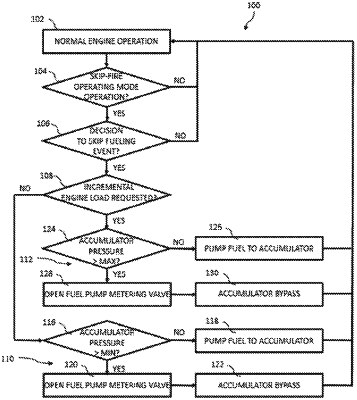| CPC F02D 41/3845 (2013.01) [F02D 41/0087 (2013.01); F02D 2200/0602 (2013.01)] | 25 Claims |

|
1. A method for operating an engine fueling system to manage fuel in an accumulator supplying fuel to an engine including multiple cylinders, comprising:
monitoring fuel load in the accumulator, wherein the accumulator is a common rail fuel accumulator connected between a high pressure fuel pump and a plurality of fuel injectors, and the high pressure pump is downstream of a lower pressure pump;
determining that the engine is operating in a cylinder deactivation mode during which one or more fueling events to one or more of the cylinders is being skipped;
determining one or more fuel delivery events is being skipped and a pressure management operation for the common rail fuel accumulator during the one or more skipped fuel delivery events; and
controlling, in response to the determination that one or more fuel delivery events is being skipped and the pressure management operation and the monitored fuel load in the common rail fuel accumulator, a supply of fuel from the high pressure fuel pump during the one or more skipped fuel delivery events by:
causing fuel to be supplied from the high pressure fuel pump to the common rail fuel accumulator if the monitored fuel load is less than or equal to a first load value; and
causing fuel from the high pressure fuel pump to be recirculated, dumped, or shunted and not be supplied to the common rail fuel accumulator if the monitored fuel load is greater than the first load value.
|